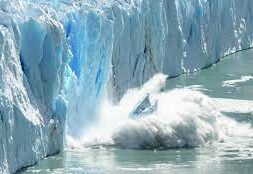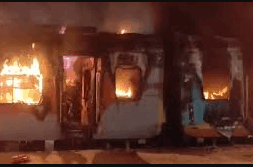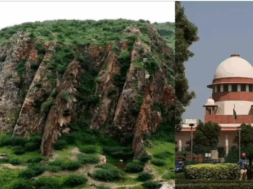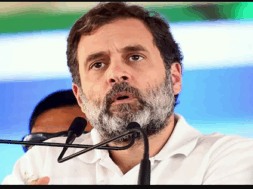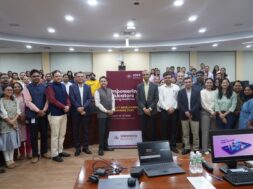
Global Warming to Rise by 2 Degrees Celsius by 2100: India May see More Heatwaves, Erratic Rainfall and Cyclonic Events: IPCC
Manas Dasgupta
NEW DELHI, Aug 9: In another grim reminder of the threat posed by global warming, the Inter-governmental Panel on Climate Change (IPCC) on Monday warned that the average global temperatures would rise by more than two degree Celsius by 2100 compared to pre-industrial times unless “deep reductions” in greenhouse gas emissions are initiated immediately.
The IPCC released the first part of its Sixth Assessment Report (AR6), its latest evaluation of the state of earth’s climate, the changes happening therein, and the impacts these are having on the planet, and life forms. The voluminous assessment reports are the most widely-accepted scientific opinion on the status of earth’s climate.
Earth’s climate is getting so hot that temperatures in about a decade will probably blow past a level of warming that world leaders have sought to prevent, the report that the United Nations calls a “code red for humanity,” said.
“It’s just guaranteed that it’s going to get worse,” said report co-author Linda Mearns, a senior climate scientist at the U.S. National Center for Atmospheric Research. “I don’t see any area that is safe … Nowhere to run, nowhere to hide.” But scientists also eased back a bit on the likelihood of the absolute worst climate catastrophes.
The authoritative IPCC report, which calls climate change clearly human-caused and “unequivocal,” makes more precise and warmer forecasts for the 21st century than it did last time it was issued in 2013.
For the Indian sub-continent, the report forecast increasing heat waves and droughts, increased rainfall events and more cyclonic activity across India and the subcontinent over the next few decades. The report also stated that heatwaves and humid heat stress will be more intense and frequent during the 21st century. Both annual and summer monsoon precipitation will increase during this century, with enhanced inter-annual variability, it further added.
For the Indian subcontinent, the report stated, “the observed mean surface temperature increase has clearly emerged out of the range of internal variability compared to 1850-1900. Heat extremes have increased while cold extremes have decreased, and these trends will continue over the coming decades.”
Average and heavy precipitation will also increase over much of Asia, it added.
The report stated that the South and Southeast Asian monsoon has weakened in the second half of the 20th century mainly due to the increase in aerosols and particulate matter due to human activity. The dry-north and wet-south pattern of East Asian summer monsoon precipitation changes are results of the combined effects of greenhouse gases and aerosols, it said.
It also stated that South and Southeast Asian monsoon and East Asian summer monsoon precipitation will be dominated by the effects of internal variability in the short term and precipitation will increase in the long term. Agricultural and ecological droughts are also expected to increase in the subcontinent, it added.
Each of five scenarios for the future, based on how much carbon emissions are cut, passes the more stringent of two thresholds set in the 2015 Paris climate agreement. World leaders agreed then to try to limit warming to 1.5° C since the late 19th century because problems mount quickly after that. The limit is only a few tenths of a degree hotter than now because the world has already warmed nearly 1.1° C in the past century and a half.
Under each scenario, the report said, the world will cross the 1.5° C warming mark in the 2030s, earlier than some past predictions. Warming has ramped up in recent years, data shows.
In three scenarios, the world will also likely exceed 2° C over pre-industrial times — the other, less stringent Paris goal — with far worse heat waves, droughts and flood-inducing downpours “unless deep reductions in carbon dioxide and other greenhouse gas emissions occur in the coming decades,” the report said.
“This report tells us that recent changes in the climate are widespread, rapid and intensifying, unprecedented in thousands of years,” said IPCC Vice Chair Ko Barrett, senior climate adviser for the U.S. National Oceanic and Atmospheric Administration. “The changes we experience will increase with further warming.”
The 3,000-plus-page report from 234 scientists said warming is already accelerating sea level rise, shrinking ice and worsening extremes such as heat waves, droughts, floods and storms. Tropical cyclones are getting stronger and wetter, while Arctic sea ice is dwindling in the summer and permafrost is thawing. All of these trends will get worse, the report said.
For example, the kind of heat wave that used to happen only once every 50 years now happens once a decade, and if the world warms another degree Celsius, it will happen twice every seven years, the report said.
As the planet warms, places will get hit more not just by extreme weather but by multiple climate disasters that occur simultaneously, the report said. That’s like what’s now happening in the Western U.S., where heat waves, drought and wildfires compound the damage, Mearns said.
Some harm from climate change — dwindling ice sheets, rising sea levels and changes in the oceans as they lose oxygen and become more acidic — are “irreversible for centuries to millennia,” the report said.
The first part of AR6, which presents scientific evidence for climate change, says that global temperatures had already risen by about 1.1 degree Celsius from pre-industrial times, a reference to the period between 1850 and 1900, and warns that a 1.5 degree Celsius warming was likely to be achieved before 2040.
The stated objective of the 2015 Paris Agreement, the international architecture to fight climate change, is to limit temperature increase to within 2 degree Celsius from pre-industrial times, hopefully within 1.5 degrees Celsius itself. Scientists say a temperature rise beyond 2 degree Celsius would result in catastrophic and irreversible changes that would make it difficult for human beings and other species to survive.
The sixth assessment report says that even if very wide-ranging and ambitious cuts in greenhouse gas emissions are initiated immediately, the temperature rise was expected to cross 1.5 degree Celsius, and reach 1.6 degree Celsius, before being reined back to 1.5 degrees Celsius.
Limiting the temperature rise to 1.5 degree Celsius, or even 2 degree Celsius, would be “beyond reach”, unless “immediate, rapid and large-scale” reductions in greenhouse gas emissions takes place, the report says.
The report says that there was now “unequivocal” evidence to say that global warming was being caused by human activities. It says “multiple lines of evidence” now supports this.
The IPCC, which was set up in 1988 by the World Meteorological Organisation (WMO) and UN Environment Programme (UNEP), does not produce any new science itself. Instead, it assembles scientists from all over the world to review all the relevant scientific literature on climate change, and arrive at general conclusions about the trends being observed.
The AR6 says that observed changes in earth’s climate, induced by global warming were unprecedented in thousands, and in some cases hundreds of thousands of years. Some of these changes, like sea-level rise, or glacier melt, would remain irreversible over hundreds of thousands of years. Sea-levels had already risen by about 20 cm, on an average, in the last 100 years, and are likely to rise further by 30 cm to one metre, depending on future emissions.
The world is “locked in” to 15 to 30 cm of sea level rise by mid-century, said report co-author Bob Kopp of Rutgers University.
Nearly all of the warming that has happened on Earth can be blamed on emissions of heat-trapping gases such as carbon dioxide and methane. At most, natural forces like the sun or simple randomness can explain one- or two-tenths of a degree of warming, the report said.
The report described five different future scenarios based on how much the world reduces carbon emissions. They are: a future with incredibly large and quick pollution cuts; another with intense pollution cuts but not quite as massive; a scenario with moderate emissions; a fourth scenario where current plans to make small pollution reductions continue; and a fifth possible future involving continued increases in carbon pollution.
In five previous reports, the world was on that final hottest path, often nicknamed “business as usual.” But this time, the world is somewhere between the moderate emissions path and the small pollution reductions scenario because of progress to curb climate change, said report co-author Claudia Tebaldi, a scientist at the U.S. Pacific Northwest National Lab.
In a way, the world can stay at the 1.5-degree threshold with extreme and quick emission cuts, but even then, warming would hit 1.5° in a decade, rise a tad and then come back down, said co-author Maisia Rojas Corrada, director of the Center for Climate and Resilience Research in Chile.
While calling the report “a code red for humanity,” United Nations Secretary-General Antonio Guterres kept a sliver of hope that world leaders could still somehow prevent 1.5° of warming, which he said is “perilously close”.
“Anything we can do to limit, to slow down, is going to pay off,” Tebaldi said. “And if we cannot get to 1.5, it’s probably going to be painful, but it’s better not to give up.”
In the report’s worst-case scenario, the world could be around 3.3° C hotter than now by the end of the century. But that scenario looks increasingly unlikely, said report co-author and climate scientist Zeke Hausfather, climate change director of the Breakthrough Institute. Both extremes are looking less likely, he said.
“We are a lot less likely to get lucky and end up with less warming than we thought. We won’t be able to meet Paris Agreement goals without rapid near-term reductions in our emissions,” Hausfather said. “At the same time, the odds of ending up in a much worse place than we expected if we do reduce our emissions are notably lower.”
The report said ultra-catastrophic disasters, commonly called “tipping points”, like ice sheet collapses and the abrupt slowdown of ocean currents are “low likelihood” but cannot be ruled out. The much talked-about shutdown of Atlantic ocean currents, which would trigger massive weather shifts, is something that’s unlikely to happen in this century, Kopp said.
The report “provides a strong sense of urgency to do even more,” said Jane Lubchenco, the White House deputy science adviser.
In a new move, scientists emphasized how cutting airborne levels of methane, a powerful but short-lived gas that has soared to record levels, could help curb short-term warming.
More than 100 countries have made informal pledges to achieve “net zero” human-caused carbon dioxide emissions sometime around mid-century, which will be a key part of climate negotiations this fall in Scotland. The report said those commitments are essential.
“It is still possible to forestall many of the most dire impacts,” Barrett said
Dr. Friederike Otto, who is the Associate Director of the Environment Change Institute, University of Oxford and one of the authors of the report, said, “The key finding of the report is that climate change is a fact, global warming is a fact and that the warming has taken places because of human influence is now well established. We have seen rapid changes across the world, with heat waves, heavy rainfall events droughts and compound events — or a mix of hot, dry and windy — preconditions for forest fires. We see this in every region of the planet. There is no going back from some of these changes. Even if we limit temperatures to 1.5 degrees Celsius from pre-industrial levels, we will continue to see extreme weather events.”
Dr. Otto added that some changes are locked in, such as rising sea levels and melting glaciers, which can now no longer be reversed. “For India, increase in heatwaves is marked by other emissions like aerosol emissions. If there is a reduction in aerosols, we will see a further increase in heat waves,” she said.
IITM’s Dr. Swapna Panickal, another author of the report, said that India will experience an intensification of the water cycle which will affect rainfall patterns as well as increased monsoon precipitation.
“In the Indian Ocean, the sea temperature is heating at a higher rate than other areas, and therefore may influence other regions. The Southwest Monsoon has declined over the past few decades because of the increase of aerosols, but once this reduces, we will experience heavy monsoon rainfall,” she said.
The global mean sea level in the Indian Ocean is rising at 3.7 meters annually, she said, adding that extreme sea level events that previously occurred once every 100 years, will now be seen nearly every year.
The report stated that the relative sea level in the Indian Ocean, around Asia, has increased faster than the global average, with coastal area loss and shoreline retreat. The Regional mean sea level will continue to rise, it added.
The report projected that in the coming decades climate changes will intensify across regions. For 1.5°C of global warming, there will be increasing heat waves, longer warm seasons and shorter cold seasons, it stated. At 2°C of global warming, heat extremes would more often reach critical tolerance thresholds for agriculture and health, it added.
Climate change is intensifying the water cycle, which brings more intense rainfall and associated flooding, as well as more intense drought in many regions, the report stated. It is also affecting rainfall patterns. In high latitudes, precipitation is likely to increase, while it is projected to decrease over large parts of the subtropics, the report stated.
It further stated that coastal areas will see continued sea level rise throughout the 21st century, contributing to more frequent and severe coastal flooding in low-lying areas and coastal erosion. For cities, some aspects of climate change may be amplified, including heat (since urban areas are usually warmer than their surroundings), flooding from heavy precipitation events and sea level rise in coastal cities.
Dr. Arunabha Ghosh, CEO, Council on Energy, Environment and Water (CEEW), said, “Given that India is one of the most climate-vulnerable countries, we must recognise that even geographically faraway climatic changes can have consequences for our monsoons and intensity of extreme events. Our focus should be on building climate-resilient physical and digital infrastructure along with inculcating social and behavioural changes in citizens and communities. Further, it should nudge the international community to capitalise a Global Resilience Reserve Fund to help lower the peaks of climate risks for the most vulnerable countries and create an insurance cushion against severe climate shocks.”
